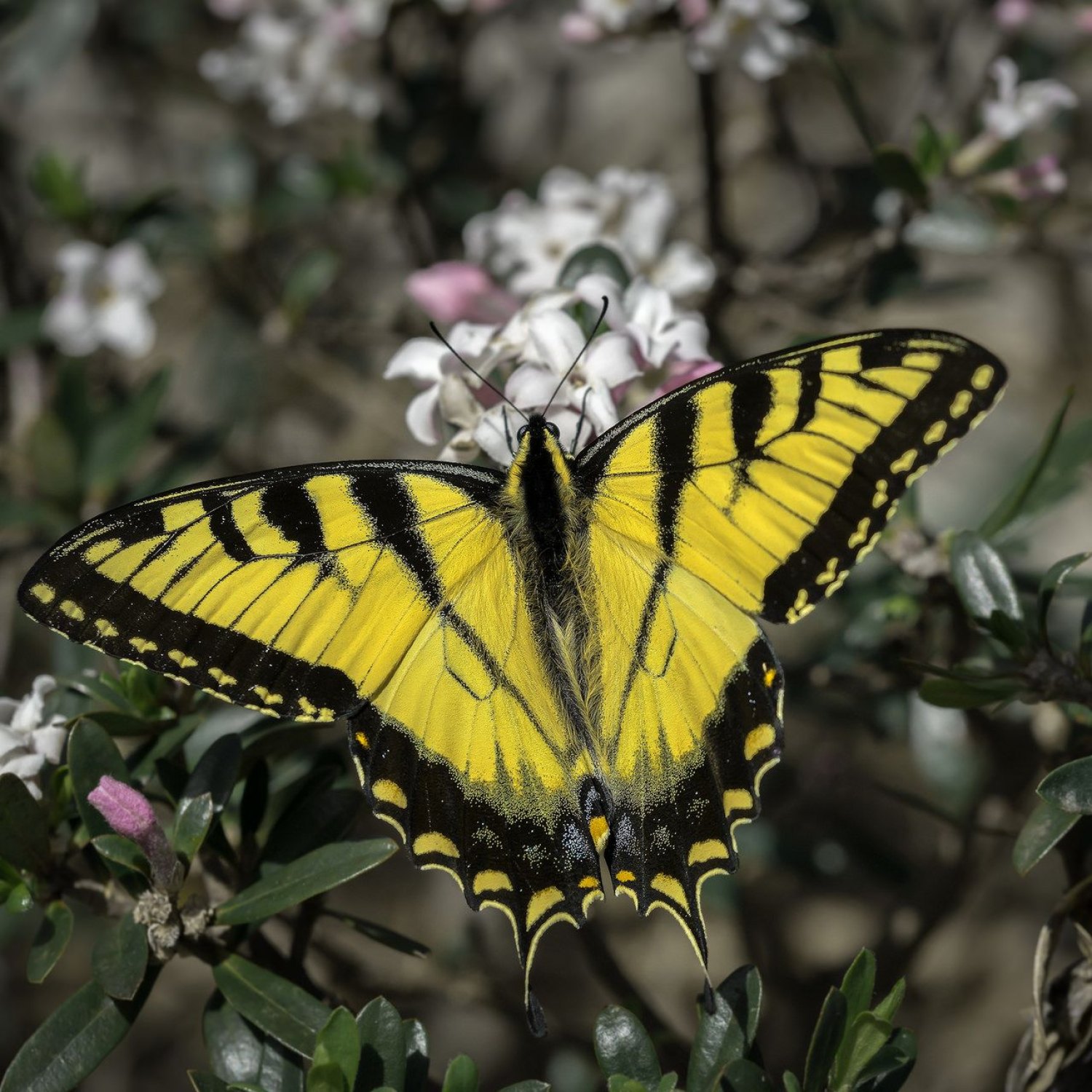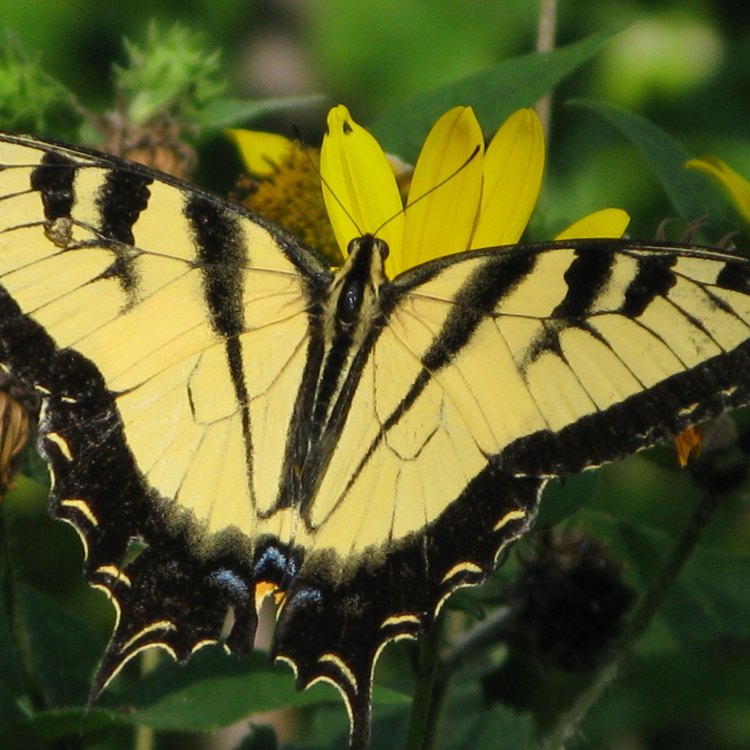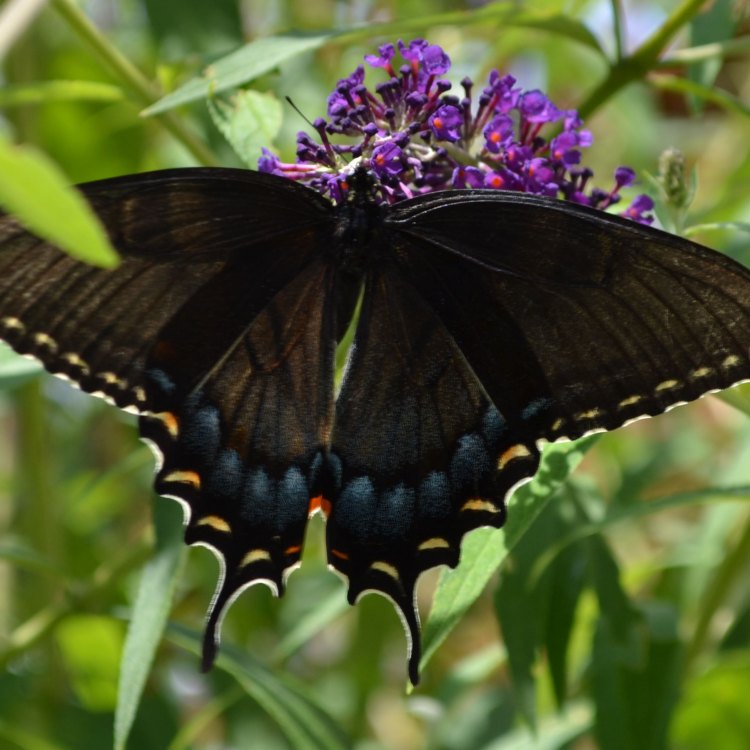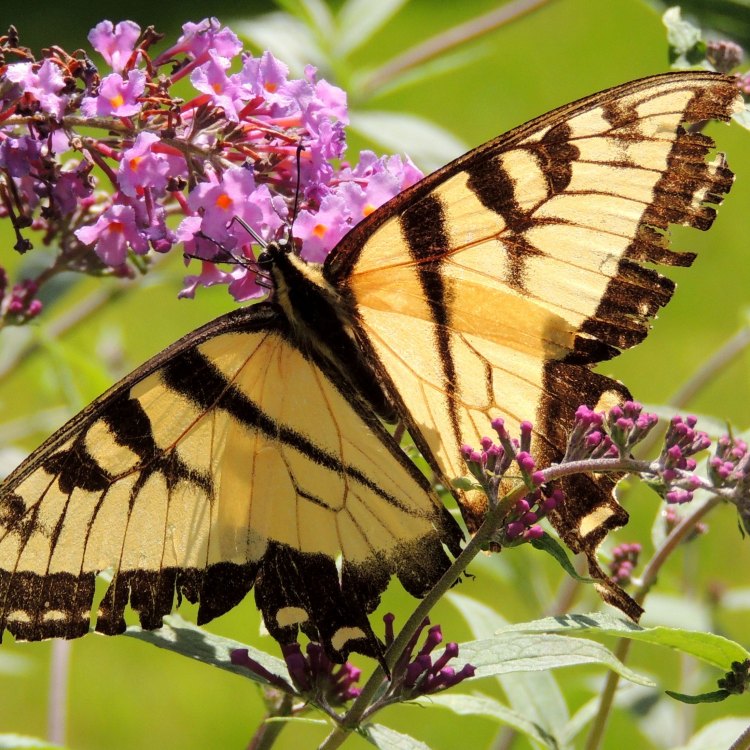
Tiger Swallowtail
3.5-6.3 inches (9-16 cm)
The Tiger Swallowtail is a stunning butterfly that can be found in the Eastern United States and Canada. With a wingspan of 3.5-6.3 inches and a distinctive body shape, it is one of the largest butterflies in the region. It belongs to the Papilionidae family and is a common sight in gardens and parks. Keep an eye out for this beautiful creature fluttering by. #TigerSwallowtail #Butterfly #EasternUS #Canada
Animal Details Summary:
Common Name: Tiger Swallowtail
Kingdom: Animalia
Habitat: Forests, woodlands, gardens
The Magnificent Tiger Swallowtail: Symbol of Beauty and Grace
Butterflies have long been admired for their ethereal beauty and graceful flight. Among the various species of butterflies, there is one that catches the eye with its vibrant yellow and black colored wings. The Tiger Swallowtail (Papilio glaucus) is a stunning creature that has captured the hearts of many with its unique appearance and behavior. In this article, we will explore everything you need to know about this fascinating butterfly, from its scientific name to its habitat and geographical distribution Tiger Swallowtail.Scientifically known as Papilio glaucus, the Tiger Swallowtail belongs to the Kingdom Animalia, under the phylum Arthropoda, class Insecta, and order Lepidoptera. Its family is Papilionidae, which is also known as the swallowtail butterflies. These butterflies are widely recognized for their distinctively shaped wings, which resemble the shape of a swallow's tail. With their signature yellow and black coloration, the Tiger Swallowtail is easily recognizable from other swallowtail species.
The Tiger Swallowtail is commonly found in the forests and woodlands of North America, making it a native species to the region. Its habitat also includes gardens and other green spaces where there is an abundance of flowers, as these butterflies feed on nectar. Their diet consists mainly of nectar from various flowers, making them important pollinators in their ecosystem.
One of the most remarkable features of the Tiger Swallowtail is its geographical distribution. It is found in the eastern United States and Canada, making it a widely distributed species in the region Toucan. With its impressive range, these butterflies have become an integral part of the ecosystem, making their presence felt in different habitats.
The Tiger Swallowtail is a large butterfly, with a wingspan of 3.5-6.3 inches (9-16 cm). The males and females have some distinct differences in their physical appearance, making it easy to identify between the two. The male butterfly has a much brighter yellow color and lacks the blue coloration found on the hindwing of the female. On the other hand, the female of the species has a more muted yellow color, with a row of blue spots on the hindwing. Both sexes have black stripes and spots on their wings, resembling the patterns of a tiger, hence the name "Tiger Swallowtail."
Apart from its beautiful coloration, the body shape of the Tiger Swallowtail is also unique. As with all butterfly species, it has a slender and elongated body, with six legs and two pairs of wings. These delicate creatures have evolved to have a lightweight and aerodynamic body, making it easier for them to fly. They are incredibly agile in the air, flapping their wings at an impressive speed of 5-12 beats per second.
The wings of the Tiger Swallowtail serve a functional purpose apart from their aesthetic appeal. They are covered in thousands of tiny scales that give the wings their characteristic coloration and pattern. These scales also help in trapping the heat from the sun, keeping the butterfly warm in colder temperatures. However, excessive touching or handling of the wings can result in the scales rubbing off, damaging the wings and affecting the butterfly's ability to fly.
Tiger Swallowtail butterflies also have a unique way of defending themselves against predators. When under threat, these butterflies can emit a pungent odor that deters predators from attacking them. This quality is commonly seen in other species of swallowtail butterflies, making it an effective method of defense.
The life cycle of the Tiger Swallowtail is also fascinating to observe. Like all butterflies, it goes through four stages - egg, larva, pupa, and adult. Their life cycle is dependent on the weather and temperature, with warmer temperatures leading to faster development. The female butterfly lays its eggs on the leaves of host plants, such as Black Cherry, Tulip Tree, and Sweetbay Magnolia. The caterpillars hatch from the eggs and spend the next few weeks feeding on the leaves of these plants, growing in size and shedding their skin several times before forming a chrysalis. Inside the chrysalis, the caterpillar undergoes metamorphosis and emerges as an adult butterfly after two weeks.
The Tiger Swallowtail's unique coloration and behavior have made it a popular subject for artists and photographers. Its mesmerizing beauty has also earned it the title of state butterfly in both Alabama and Virginia. The butterfly has also been featured on stamps, coins, and other commemorative items, further showcasing its popularity and significance.
In conclusion, the Tiger Swallowtail is undoubtedly a magnificent creature that holds a special place in the hearts of nature enthusiasts. Its vibrant colors, graceful flight, and fascinating behavior make it a beloved species in the Eastern United States and Canada. As with all other butterfly species, the Tiger Swallowtail's existence is threatened by habitat destruction and climate change. It is crucial to protect and conserve these butterflies and their habitats to ensure their survival for future generations to appreciate and admire their beauty.

Tiger Swallowtail
Animal Details Tiger Swallowtail - Scientific Name: Papilio glaucus
- Category: Animals T
- Scientific Name: Papilio glaucus
- Common Name: Tiger Swallowtail
- Kingdom: Animalia
- Phylum: Arthropoda
- Class: Insecta
- Order: Lepidoptera
- Family: Papilionidae
- Habitat: Forests, woodlands, gardens
- Feeding Method: Nectar from flowers
- Geographical Distribution: North America
- Country of Origin: United States
- Location: Eastern United States and Canada
- Animal Coloration: Yellow and black
- Body Shape: Butterfly
- Length: 3.5-6.3 inches (9-16 cm)

Tiger Swallowtail
- Adult Size: Large
- Average Lifespan: Approximately 2 weeks
- Reproduction: Sexual
- Reproductive Behavior: Mating occurs in the air
- Sound or Call: None
- Migration Pattern: Some populations migrate
- Social Groups: Solitary
- Behavior: Active during the day (diurnal)
- Threats: Habitat loss, pesticides
- Conservation Status: Least Concern
- Impact on Ecosystem: Pollination of flowers
- Human Use: Gardening, eco-tourism
- Distinctive Features: Large black wings with yellow stripes
- Interesting Facts: Females have larger wingspans than males
- Predator: Birds, spiders

Papilio glaucus
The Marvelous World of the Tiger Swallowtail Butterfly
As spring turns to summer and flowers begin to bloom, the colorful and graceful butterfly appears, adding a dash of joy to our surroundings. Among the variety of butterfly species found around the world, the Tiger Swallowtail (Papilio glaucus) stands out with its large size, distinctive features, and intriguing behavior. Native to North America, these beautiful creatures have captured the hearts of many with their vibrant colors, delicate wings, and fascinating life cycle.So, let’s take a closer look at the marvels of this magnificent butterfly and learn more about its unique features, behavior, and impact on the ecosystem PeaceOfAnimals.Com.
The Basics: Size, Lifespan, and Reproduction
With an adult size ranging from 2.5 to 4.5 inches, the Tiger Swallowtail is considered a large butterfly species. They have striking black wings with notable yellow stripes, making them easily distinguishable from other butterflies. The females have a larger wingspan than males, measuring up to 6 inches, while males have a wingspan of 4 inches on average.The average lifespan of a Tiger Swallowtail is approximately 2 weeks, making them short-lived creatures. However, during this brief span, they play a crucial role in the ecosystem, which we’ll discuss later in the article.
Reproduction in Tiger Swallowtails is a sexual process that starts with courtship. Male butterflies actively chase females, flying in a zigzag pattern to attract their attention Tibetan Fox. Once the female accepts the male’s advances, they mate in the air. This unique behavior has earned them the nickname “air dancers,” and it’s often referred to as one of the most beautiful courtship rituals in the insect world.
Behavior, Migration, and Social Groups
Tiger Swallowtails are active during the day, making them diurnal creatures. They can be seen fluttering from flower to flower, seeking nectar, and basking in the warmth of the sun. These butterflies are highly active, often flying for long distances in search of food, mates, and suitable breeding grounds.Some populations of Tiger Swallowtails are known to migrate, although not all do. The ones that do migrate usually travel short distances, unlike the Monarch butterfly, which is known for its impressive long-distance migrations. Migration patterns depend on the availability of food sources and climate conditions, and not all populations have the necessary resources to undertake long journeys.
Unlike some species of butterflies that form social groups or colonies, Tiger Swallowtails are solitary creatures. They spend most of their lives alone, only coming together for mating or feeding purposes. This solitary nature is one of the factors that make them elusive and harder to study in the wild.
Threats and Conservation Status
Like many other species in the natural world, Tiger Swallowtails are facing threats to their survival. Habitat loss and degradation are the primary reasons behind the decline of their populations. As urbanization and deforestation continue to spread, butterfly habitats are destroyed, and their food sources become scarce. Moreover, the use of pesticides in agriculture has also taken a toll on these beautiful creatures, impacting their reproductive success and overall health.Despite these challenges, the Tiger Swallowtail is currently listed as “Least Concern” on the IUCN Red List of Threatened Species. This means that while their populations are declining in some areas, they are still widespread and relatively common. However, it’s important to note that even the slightest change in their habitats and environment can have a significant impact on their survival, making conservation efforts crucial.
The Butterfly Effect: Impact on the Ecosystem
Butterflies, like the Tiger Swallowtail, play a vital role in maintaining a balanced ecosystem. As pollinators, they are responsible for the reproduction of many plant species, making them essential for the survival of various ecosystems. When they feed on nectar from flowers, they also transfer pollen from one flower to another, allowing flowers to produce fruits and seeds.Moreover, as caterpillars, Tiger Swallowtails provide a food source for many predators, including birds and spiders. Their presence in the natural world creates a chain reaction, as they help maintain the balance between insects and other organisms, keeping the ecosystem healthy.
Human Use: Gardening and Eco-tourism
Aside from their impact on the ecosystem, Tiger Swallowtails also have a significant presence in human-made environments. These butterflies are often seen fluttering around gardens, backyard flower beds, and parks, where they provide a beautiful sight for nature lovers and gardeners.In recent years, eco-tourism has also become a popular way for people to connect with these creatures. Many nature lovers and enthusiasts travel to butterfly conservatories and gardens to observe these colorful creatures in their natural habitats. This tourism not only creates awareness about the importance of conserving these insects, but it also helps generate revenue for conservation efforts and supports the local economy.
The Distinctive Features of the Tiger Swallowtail
One of the most striking features of the Tiger Swallowtail is its large black wings with bold yellow stripes. This pattern is often referred to as “tiger-like,” hence the name of the butterfly. This unique coloration serves as a defense mechanism, making them difficult to spot by predators when they blend in with their surroundings.Another interesting feature of the Tiger Swallowtail is that the females have larger wingspans than males. This size difference is believed to help improve their reproductive success, as larger females tend to produce more eggs. This strategy also helps ensure that their offspring will have a better chance of survival, as larger females can produce more energy-rich eggs.
Predators and Survival Strategies
Like most animals, butterflies also have natural predators, and the Tiger Swallowtail is no exception. Their main predators include birds, spiders, and wasps, which primarily target their eggs and caterpillars. To protect themselves, Tiger Swallowtails have developed survival strategies such as camouflage, mimicry, and coloration.Their camouflage is their first line of defense, as their unique coloration helps them blend in with their surroundings, making it difficult for predators to spot them. Some species of Tiger Swallowtails also use mimicry, where they imitate the appearance of unpalatable or poisonous butterflies, thus tricking predators and keeping themselves safe.
The Tiger Swallowtail – A Symbol of Hope and Wonder
In conclusion, the Tiger Swallowtail is more than just a beautiful butterfly – it’s a symbol of hope and wonder in the natural world. These magnificent creatures remind us of the interconnectedness and delicate balance of our planet’s ecosystems. Their presence enriches our surroundings, and their survival depends on our collective efforts to protect them and their habitats.So the next time you see a Tiger Swallowtail fluttering by, take a moment to appreciate its beauty and the wonders of nature. And remember, our actions, big or small, can have a profound impact on these delicate creatures and the world we share. Let’s work together to conserve and protect the marvels of the natural world, including the Tiger Swallowtail butterfly.

The Magnificent Tiger Swallowtail: Symbol of Beauty and Grace
Disclaimer: The content provided is for informational purposes only. We cannot guarantee the accuracy of the information on this page 100%. All information provided here may change without prior notice.












